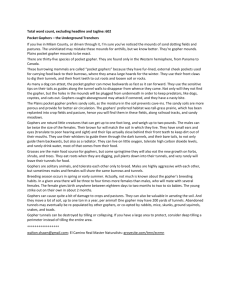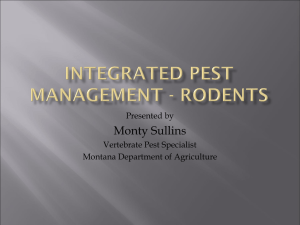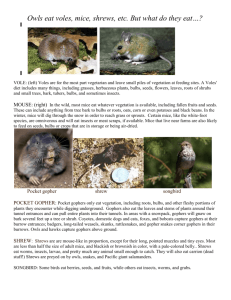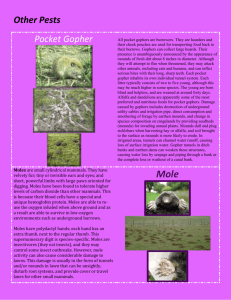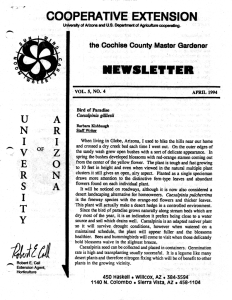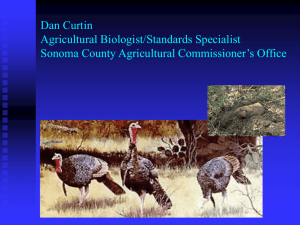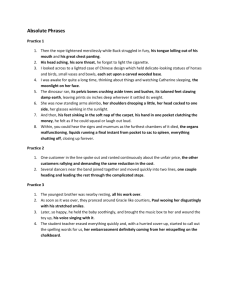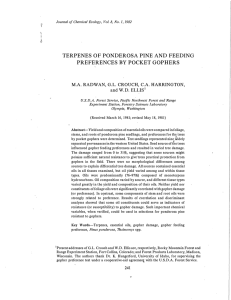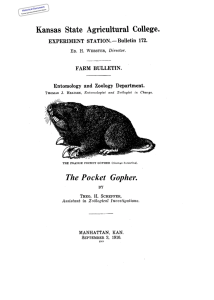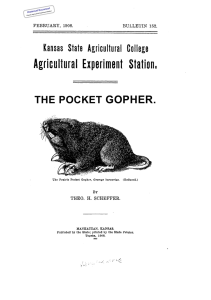Managing Pocket Gophers
advertisement
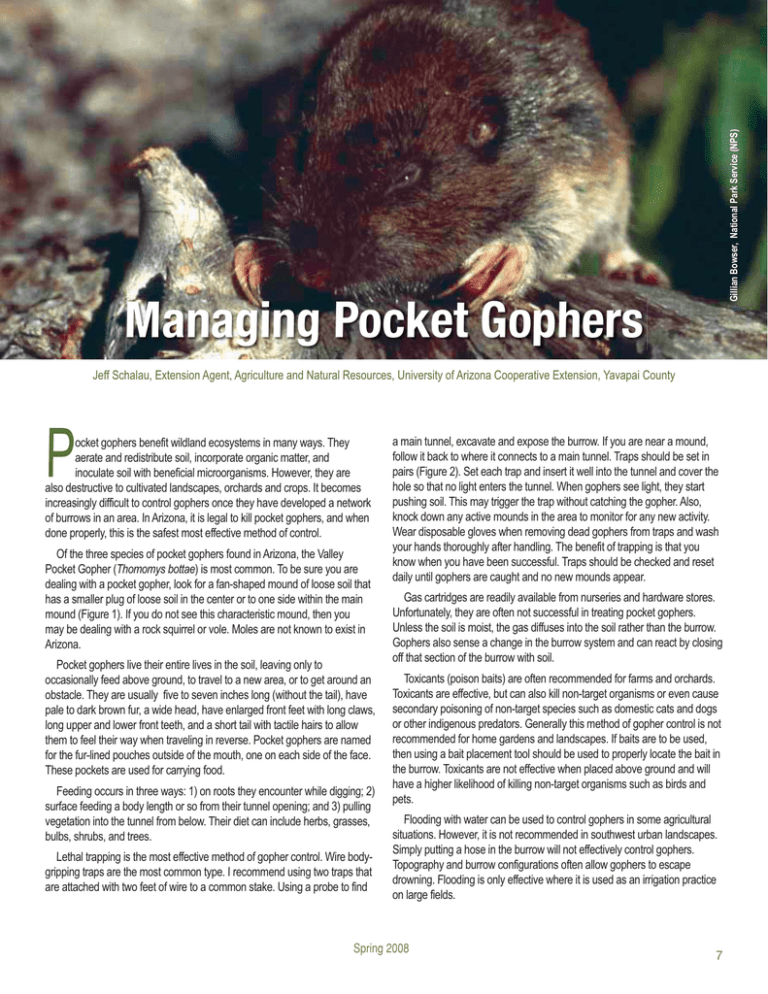
Gillian Bowser, National Park Service (NPS) Managing Pocket Gophers Jeff Schalau, Extension Agent, Agriculture and Natural Resources, University of Arizona Cooperative Extension, Yavapai County P ocket gophers benefit wildland ecosystems in many ways. They aerate and redistribute soil, incorporate organic matter, and inoculate soil with beneficial microorganisms. However, they are also destructive to cultivated landscapes, orchards and crops. It becomes increasingly difficult to control gophers once they have developed a network of burrows in an area. In Arizona, it is legal to kill pocket gophers, and when done properly, this is the safest most effective method of control. Of the three species of pocket gophers found in Arizona, the Valley Pocket Gopher (Thomomys bottae) is most common. To be sure you are dealing with a pocket gopher, look for a fan-shaped mound of loose soil that has a smaller plug of loose soil in the center or to one side within the main mound (Figure 1). If you do not see this characteristic mound, then you may be dealing with a rock squirrel or vole. Moles are not known to exist in Arizona. Pocket gophers live their entire lives in the soil, leaving only to occasionally feed above ground, to travel to a new area, or to get around an obstacle. They are usually five to seven inches long (without the tail), have pale to dark brown fur, a wide head, have enlarged front feet with long claws, long upper and lower front teeth, and a short tail with tactile hairs to allow them to feel their way when traveling in reverse. Pocket gophers are named for the fur-lined pouches outside of the mouth, one on each side of the face. These pockets are used for carrying food. Feeding occurs in three ways: 1) on roots they encounter while digging; 2) surface feeding a body length or so from their tunnel opening; and 3) pulling vegetation into the tunnel from below. Their diet can include herbs, grasses, bulbs, shrubs, and trees. Lethal trapping is the most effective method of gopher control. Wire bodygripping traps are the most common type. I recommend using two traps that are attached with two feet of wire to a common stake. Using a probe to find a main tunnel, excavate and expose the burrow. If you are near a mound, follow it back to where it connects to a main tunnel. Traps should be set in pairs (Figure 2). Set each trap and insert it well into the tunnel and cover the hole so that no light enters the tunnel. When gophers see light, they start pushing soil. This may trigger the trap without catching the gopher. Also, knock down any active mounds in the area to monitor for any new activity. Wear disposable gloves when removing dead gophers from traps and wash your hands thoroughly after handling. The benefit of trapping is that you know when you have been successful. Traps should be checked and reset daily until gophers are caught and no new mounds appear. Gas cartridges are readily available from nurseries and hardware stores. Unfortunately, they are often not successful in treating pocket gophers. Unless the soil is moist, the gas diffuses into the soil rather than the burrow. Gophers also sense a change in the burrow system and can react by closing off that section of the burrow with soil. Toxicants (poison baits) are often recommended for farms and orchards. Toxicants are effective, but can also kill non-target organisms or even cause secondary poisoning of non-target species such as domestic cats and dogs or other indigenous predators. Generally this method of gopher control is not recommended for home gardens and landscapes. If baits are to be used, then using a bait placement tool should be used to properly locate the bait in the burrow. Toxicants are not effective when placed above ground and will have a higher likelihood of killing non-target organisms such as birds and pets. Flooding with water can be used to control gophers in some agricultural situations. However, it is not recommended in southwest urban landscapes. Simply putting a hose in the burrow will not effectively control gophers. Topography and burrow configurations often allow gophers to escape drowning. Flooding is only effective where it is used as an irrigation practice on large fields. Spring 2008 7 Figure 1. Pocket gopher mound University of Nebraska Old burrow systems should also be obliterated whenever possible. Existing burrows serve as pocket gopher highways that connect neighboring open space to your cultivated areas. Dogs and cats can act as biological control agents, but it really depends on the individual animal’s hunting ability. Digging dogs can also be very destructive – maybe more so than the gopher. Sound emitting devices and windmills are generally ineffective as a control. Jeff Schalau Pocket gophers can be excluded from small areas by creating a barrier. This is achieved by digging a trench 24-36 inches deep, and building a barrier of sheet metal, concrete, or hardware cloth. Remember, the barrier should also extend at least 12 inches above ground. Problems with exclusion include excessively rocky soil and the occasional creative gopher that will dig under the barrier. Raised garden beds can be lined with hardware cloth. Effective pocket gopher management requires observation and persistence. Over time, you will reduce the gopher population on your property and minimize damage to your garden, orchard and landscape. Figure 2. Setting traps for pocket gophers. Determining Ponderosa Pine Tree Density on Small Lots Tom DeGomez, Forest Health Specialist, School of Natural Resources, University of Arizona P ast land management practices have often resulted in ponderosa pine stands that are overly dense, growing offsite, and prone to catastrophic wildfire, drought or bark beetle outbreaks3,4,5. Landowners and property managers in the Southwest now are faced with determining appropriate ways to prevent these potentially stand-replacing events. The best way to reduce wildfire threat, drought damage and attack by bark beetles is to lower stand density through mechanical thinning. An additional benefit from reducing stand density is that remaining trees will grow more rapidly than when in an over-stocked condition. A century of research has shown that tree diameters increase at a faster rate in stands with lower densities, and ponderosa pine is no exception7. Thinning can greatly increase under story plant density in ponderosa pine forests2,6. Herbaceous plant growth, both grasses and forbes, typically increases when additional light reaches the forest floor. A potential drawback to thinning may be the perception that the property’s scenic beauty will be spoiled. Brown and Daniel (1986) found, in their study of predicting scenic beauty in ponderosa pine stands, that less dense (more open) stands had greater scenic value. The major components of higher preference were the increase in herbaceous plant growth and the remaining mature trees. (Refer to Figures 1a&b for a visual representation of various basal areas in a ponderosa pine stand with even-aged management.) 8 Figures 1a and 1b. Photos represent basal areas of approximately 60 and 120 square feet per acre, from an even aged stand in Flagstaff, Arizona. HOW TO DETERMINE IF THE STAND HAS THE PROPER STOCKING RATE Foresters use the term basal area to describe this stocking rate (or trees per acre when including their size in diameter); it is the total cross-sectional area of the tree in square feet measured at breast height. On small lots of 1-3 acres each tree can be counted and measured to determine the basal area of the stand. Table 1 will help determine the basal area of each tree in each plot or each tree on the property if every tree is being measured. Use a flexible measuring tape (inches) to determine the circumference of each tree at 4.5 feet above the ground. Then multiply the number of trees in each diameter class times the basal area per tree (found in Table 1). Totaling all the trees and basal areas will give the total number of trees and total basal area for each plot sampled. (Note that inches become square feet in the conversion.) Adding in other tree species such as oak and juniper can help in getting a total assessment of the property. Table 2 can assist in choosing the target basal area for thinning the property. Once the target basal area is determined for the stand, refer back & Backyards Beyond
